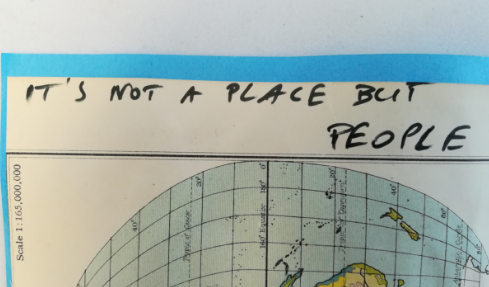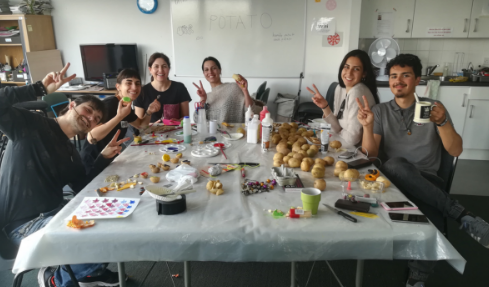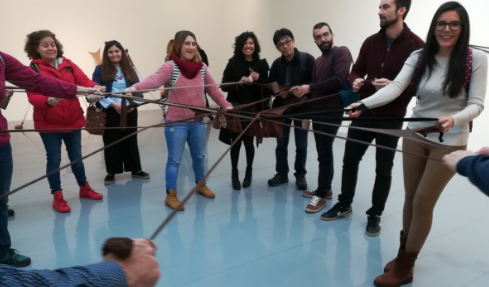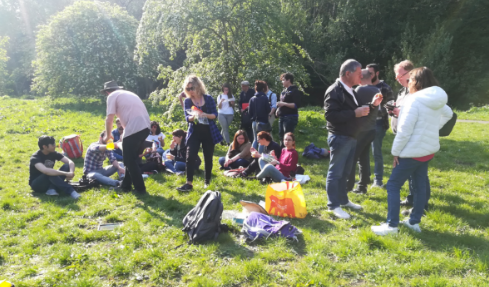
Artist Kate Temple blogs about collaborating with The Welcoming on designing creative workshops and sharing good practice.
I was awarded funding from Creative Scotland's See Learn Share fund to collaborate with The Welcoming on designing their creative programme and sharing good practice in community engagement.
I was keen to explore the simple question: what makes a workshop feel special?- Kate Temple
The Welcoming is a charity that supports migrants and refugees to build new lives in Edinburgh and become active members of the community. They also create opportunities for locals and newcomers to come together, to share experiences, celebrate diversity and learn together.
With over a decade of experience working in community learning and engagement, and having facilitated many, many workshops, I was keen to explore the simple question: what makes a workshop feel special?
I know that occasionally there is an atmosphere in the room; a buzz, an energy, a flow, a dissolve between facilitator/s and participant/s, a feeling that this is the most exciting place to be, the only place to be. A feeling that together we can make incredible things happen. A feeling that we want to be here, right now.
This doesn't happen all the time, in fact it happens quite rarely. As an artist, workshop designer and facilitator, how can I use my experience and creative skills to create this experience for participants? How can my workshops be as good as they can be? What are the factors to make this magic happen? Is this a chance event, a fleeting feeling, or is it something that I can have more control over? How can my workshops feel safe, exciting, fulfilling and important?
In early conversations with The Welcoming, we discussed the questions they were considering as an organisation, especially in relation to the creative arts programme. What are effective ways of involving migrant and refugee participants, especially the most hard to reach and marginalised?
What nature of provision works best and why? How can we make space for participants to lead in the planning, implementation and evaluation of the programme? In what ways can the creative arts support communities be more connected? How can we share our learning?
The Welcoming has a space in their programme called Creative Space. We decided early on to try four very different approaches to workshops in Creative Space, all the while keeping accessibility at the heart of our thinking and considering the individual experience within the group experience.
From early discussions, it emerged that the important things about Creative Space that we needed to keep were it's drop-in nature (every Saturday, 12-4pm), as a way to connect with artists and locals, as a social space, and an informal gathering space.
The Manifesto Workshop
For our first workshop we invited participants to create a manifesto for Creative Space.
There were a lot of people already at Creative Space when I arrived; playing Pictionary, playing chess, chatting. I brought a cake and some daffodils and there were snacks laid out. Music was playing. People continued to arrive throughout the afternoon. I set out a big table with materials for manifesto making, poster making, monoprinting.
The Potato Workshop

For our second workshop we had the theme 'potato'. We kept the back part of the room as the 'games' area and the front part as the 'making' area. We had a pot-luck, potato-themed lunch.
The Gallery Workshop

For our third workshop we went to The Fruitmarket Gallery to look at the Senga Nengudi exhibition. The Welcoming do a lot of trips, so I was keen to explore how these could be more creative. We had a short, simple intro to the exhibition from Fruitmarket staff, and then got into small groups and chose some art user[1]cards. The Fruitmarket provided some tights that I gave to everybody and fairly organically we created a group moving tight/body sculpture.
The Walking Workshop

This workshop started at The Welcoming and walked down the Water of Leith, culminating in a picnic. The Welcoming do a lot of excursions/trips/walks, so we were thinking how these could be more interactive/creative.
We made a lot of creative prompts, for example I gave everybody a concertina paper book, some paperclips and an envelope as a kind of 'walk journal' encouraging people to collect/draw/write/etc. We tried various styles of walking: silent walking, backwards walking etc. We made cyanotypes at the final picnic spot.
Having come to the end of my work with The Welcoming, what stays with me most is the warmth and openness of the atmosphere created by The Welcoming staff in the workshops. I will always keep that atmosphere at the heart of my thinking and planning for future projects, and I hope my input has impacted how The Welcoming will use a creative approach across their programme.
Having just started this blog, I met a participant on the street on her way to her new job and she said 'I will continue to go The Welcoming. It's a special place.' Let's work for our work to be special.
Kate Temple is an artist based in Edinburgh. Images courtesy of Kate Temple.